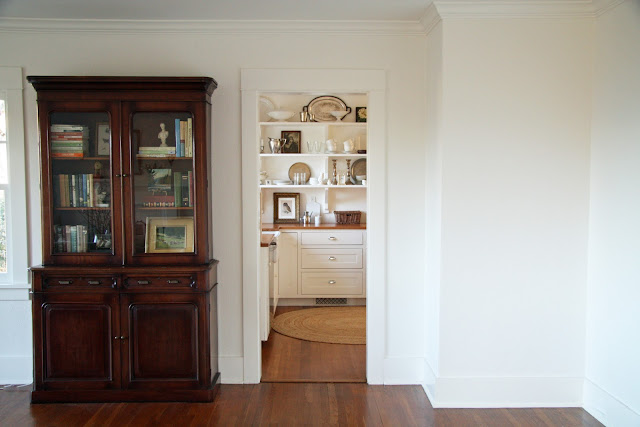Before.....
Horribly overexposed before photo.
Where the dishwasher on wheels use to be.
Looking from living room with view of old overhead cabinets.
Looking towards old dining nook.
Although we knew we would be remodeling the kitchen at some point, we were thinking that we could live in it 'as is' for awhile. So how does one go from the 'as is' status to a full blown gutting? Well, it all began with the stove. The original owners accidentally removed the stove that was there so I began to look for a cheap temporary stove. Well, we started thinking that if we're going to spend $200 on a cheap stove, we might as well spend a bit more for a permanent one. We took that rationale with about everything that followed and so it goes, we ended up gutting the kitchen on one lazy summer afternoon.
Taking up flooring.
As a note for safety, I would like to add that we sent out samples of all of our flooring. We were lucky in that the layers of linoleum were all asbestos-free BUT some linoleum squares used to line the cabinets, did test positive and were removed using extra precautions.
After peeling away several layers of flooring, hubby discovered the original fir floors - never used, although did sustain thousands of staples from flooring above it. Once the cabinets were out (donated to our local Re-Build It Center), the electrician came, creating huge holes in the original plaster so we used dry wall to patch holes and then re-plastered the walls.
We hired a cabinetmaker just up the road to build our cabinets. It was important to us for the cabinets to be free from the chemicals used in most modern cabinetry. We also wanted to recreate a nice old country kitchen that would allow for some more modern conveniences (dishwasher, stove, etc. )
The cabinets are inset (like the original cabinets were) and mimic the Shaker paneling of the built-in pie safe we chose to save and use as a pantry. It took forever to paint all of the cabinets.
The cabinets are inset (like the original cabinets were) and mimic the Shaker paneling of the built-in pie safe we chose to save and use as a pantry. It took forever to paint all of the cabinets.
This is the interior of the old pie safe, which I've since learned is an old California Cooler. See bottom link for more on that. We didn't touch the old interior shelving. All they needed was to be wiped down with a damp sponge.
Go here to read about the old pie safe (California Cooler).
We ended up finding some great butcher block from IKEA which was only $80 for one long slab. We needed three, so we ended up spending about $240 on our counter materials - great deal. We bought food safe stain from the Environmental Supply Store to bring out a nice rich hue in the wood. The product we used was by Safecoat, the color we chose was cedar.
After...
Note: This was all completed the first year we owned the house (minus the Marvin window). It was several months later, after we hired the contractor for Phase II of our remodel, that an engineer arrived on site to establish our structural support needs for the the new dormer upstairs. A real sweet old-school engineer from the Midwest showed up (adorable man) and during our first round of talks, suggested that we carry the dormer load on a support post that would run from the upstairs, through my brand new 'old-fashioned' kitchen, and down into the basement.
This was a blow as you can imagine. So when I turned to him and said, "there must be another way, I don't want to run a "large beam through my kitchen," he responded with an innocent query as to whether we'd be "updating" it soon anyway. At first I was offended as obviously (or not), we just did that! They found another way to support the dormer, and in the end we decided that it was a complement as we apparently had pulled off our goal of making the kitchen look original!

































0 comments:
Post a Comment